Coming of the railroad. Adam Winn Sr., a prominent free black landowner, sold much of present-day Center Street land to Wilmington & Raleigh Railroad (which was renamed the Wilmington & Weldon Railroad in 1855). The rail line was completed in 1840.
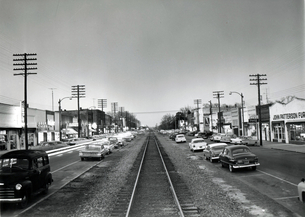
Naming and first post office. Tradition says that the town was named for the Biblical Mount Olive Olives by Benjamin Oliver, a Duplin County planter and devout Baptist. The first post office was established with Dr. Gideon Monroe Roberts as the postmaster.
The first streets and lots were laid off by the town’s founders – Benjamin Oliver, Dr. Gideon Monroe Roberts, Joel Loftin, Daniel K. Kornegay, A.B. Humphrey and David C. Maxwell.
Union Raid. On December 16, Union Major Jeptha Garrard raided the town with 500 troops, burned the depot and broke the rail line.
Union Encampment. Between March 24 and April 10, about 4,000 Union troops encamped throughout the town after the Battle of Bentonville in nearby Johnston County. Major General Judson Kilpatrick, General William Sherman’s Calvary commander, was present.
Mount Olive’s incorporation. The town received its charter of incorporation on March 1st from the State of North Carolina.
Truck farming and the produce market. James A. Westbrook moved to town in 1880, and soon “developed the largest truck farm in North Carolina and became the largest strawberry grower in the South.” By 1900, Mount Olive was “the center of the berry market” and its produce market “was the leading one in North Carolina.”
Newspaper reporter George Melvin Carr observed that “the inhabitants [of Mount Olive] are not only enlightened and clever, but are also widely noted for their generosity and kindness.”
First Brokerage. Established by W. Frank English. Council Wooten Oliver Sr. joined the business in 1904, and English & Oliver remained in operation until 1958.
Bank of Mount Olive chartered, January 29th. When it opened at 102 South Center Street, it had $10,000 in capital and one employee, the cashier, Matthew Thompson “Pete” Breazeale (who later served as mayor and for whom Breazeale Avenue is named.) The bank was moved to 100 North Center Street in 1964 and renamed Southern Bank & Trust Company in 1967. The corporate offices were relocated to 116 East Main Street in 2001. As of 2018, the bank had 67 branches in Eastern North Carolina and Virginia, over 600 employees and assets exceeding $2 billion.
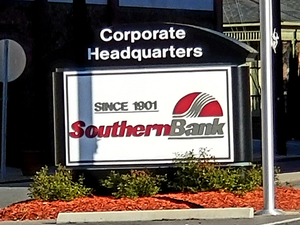
Twentieth Century Club, organized December 9th. This is the oldest literary society in Wayne County and is still active.
Mount Olive Fire Department organized. The first chief was M.T. “Pete” Breazeale, and he oversaw a volunteer department that responded to calls using a man-pulled wagon bearing a hand-operated pump and hose which was later replaced by a horse-pulled wagon. In 1926, the department acquired “Old 75”, the first gasoline-powered fire engine. The department restored Old 75 and uses it today for special events.
Mount Olive Tribune. First owned and published by Fred Mintz, the Tribune is still in publication.
Passenger train depot. Built in 1910 at the intersection of North Center and West College streets, the depot was relocated to its current location at 110 West Main Street. Rehabilitated in 2010 with a $434,000 grant from the American Recovery and Reinvestment Act, it is now known as the Historic Train Depot and is used as a Civic Center.
W.P. Martin Store. Established by William Preston Martin and Norman Price at 131 North Center Street, the store is Mount Olive’s oldest continuous business. It is now located at 111 North Center.
Great War Memorial. The Mount Olive Woman’s Club erected this two-sided memorial in honor of World War I veterans. For years, circus and farm animals drank water from the street side trough and people drank from the sidewalk fountain. Moved to its current site at 124 North Center Street in 1978, the memorial is no longer operational as a fountain.
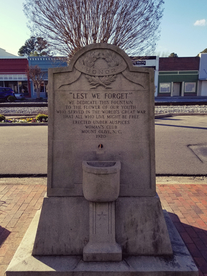
Carver School. First erected at 612 South Breazeale Avenue to serve the community’s African-American students, the school was named for George Washington Carver. The current facility was built in 1941 after a 1939 fire. In 1947, it was the first Wayne County school to earn accreditation by the Southern Association of Colleges and Schools. It served as an integrated elementary school from 1970 to 1997. In 2009, the facility was renamed to Carver Cultural Center and now houses the offices of several nonprofit organizations and a number of town athletic activities.
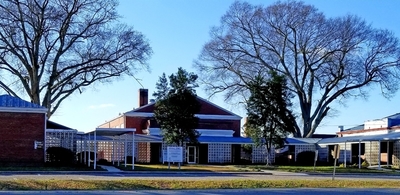
Mount Olive High School. Built at 207 Wooten Street, this facility served as the high school for the community’s white students until 1965. From then until the early 1990s, the site served as Mount Olive Junior High/Middle School. In 1997, the Mount Olive Area Historical Society led an effort to save the original three-story classroom building and auditorium from demolition. Now owned by the University of Mount Olive, the J. William and Marvis E. “Marcy” Byrd Building houses student apartments, the Department of Music, and the Hazel Kornegay Auditorium. Listed in the National Register of Historic Places.
Mt. Olive Pickle Company. Inspired by a failed business proposition to sell brined cucumbers, business leaders in town realized that if they could create a new market for local farmers; the whole town would benefit. On January 2, they established the Mt. Olive Pickle Company for the purpose of packing and selling its own brands of pickles. The company, with 37 local investors that first year, started with less than $19,000 in capital, a 3,600 square foot building, and one acre of land. Today the company manufactures the best-selling brand of pickles, peppers and relishes in the US.
.jpg)
Garris Funeral Home. Established by L.E. Garris and now located at 812 South Center Street, it is the town’s oldest continuous African-American business.
Mount Olive Post Office. Constructed at 124 West James Street, this facility served as the town’s post office until 1992 when it relocated to College Plaza Shopping Center. Purchased by Robert and Joyce Rice in 1995, it was rehabilitated and opened in 1997 as Rice and Edwards law firm. Described as “one of Mount Olive’s most sophisticated buildings,” it is listed in the National Register of Historic Places.
Steele Memorial Library. Named for beloved physician Dr. William Calvin Steele, a strong public library advocate, the library’s history is marked with public fundraising campaigns for each of its three homes. It was originally built at 110 North Chestnut Street by North Carolina’s Emergency Relief Administration with local financial support. Between 1995 and 2014, the library was housed at 111 North Chestnut Street, and it opened in its present location at 119 West Main Street in 2014.
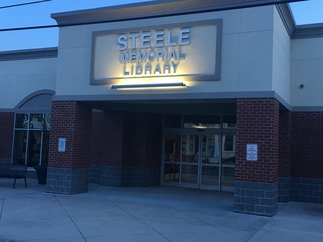
First Pickle Festival. Held May 15th-17th to celebrate the success of the Mt. Olive Pickle Company, the festival was sponsored by the Mount Olive Chamber of Commerce and the Mount Olive Jaycees with support by area merchants and the town. An estimated 5,000 attended, including North Carolina Governor W. Kerr Scott. The festival was not held again until 1987, when it became the North Carolina Pickle Festival. Tens of thousands of people attend the event annually on the last full weekend of April.
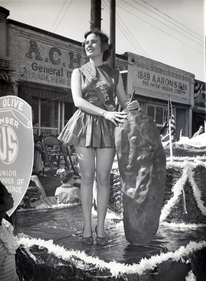
Mount Allen Junior College (now the University of Mount Olive). The Convention of Original Free Will Baptists purchased the abandoned elementary school at 201 North Breazeale Avenue to house its college. The first collegiate class in 1954 had 22 students. The institution was renamed Mount Olive Junior College in 1955, and in 1965 it moved most of its activities to its current campus on Henderson Street. It became Mount Olive College in 1970 and the University of Mount Olive in 2014.
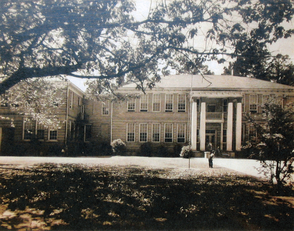
Rescue Squad. Organized as part of the Civil Defense Agency with Guy McGee, Jr. as first captain, the volunteer squad was moved into the Civil Defense Building at 114 East James Street in 1962. The first vehicle was a World War II Jeep. The squad was separated from the Civil Defense Agency in 1964 and relocated to 700 Northwest Center Street in 1973. Operations were assumed by Wayne County in 2003.
Centennial Celebration. Held April 9th-15th, centennial activities included “The Mount Olive Revue,” an outdoor drama.
First Shopping Center – College Plaza. Village Plaza followed in 1977 (purchased by Bobby Denning in 1992) and Mt. Olive Centre in 1988.
New Year’s Eve Pickle Drop. Led by President Emeritus John N. Walker, a few pickle company employees held the first New Year’s Eve Pickle Drop as a stunt to mark Mt. Olive’s designation as the Official Pickle and Pepper of the Millennium. Eight people attended, including the company’s mascot at the time, Mr. Crisp. The event first welcomed the public in 2001, and about 250 people attended. It continues to be held annually, with up to several thousand arriving in time to see a glowing pickle plunge down the company’s flagpole at 7 o’clock sharp.
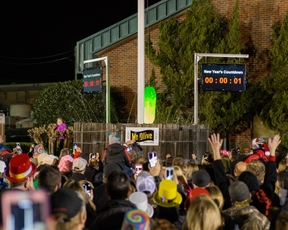
Historic District. Mount Olive’s historic district came into being on May 27th when it was officially listed in the National Register of Historic Places.
Kids World Playground. The community rallied around this project in 2000, raising $133,000 for the materials. It was built in Westbrook Park by 1,700 volunteers over five days, October 11th-15th.
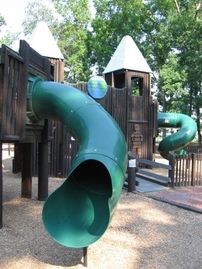
Winn Family Marker. The only family historic marker in Mount Olive honors the Winns, a family of Native and African-American heritage whose land was originally purchased to establish the town. Members served in political, educational, religious and judicial positions in Mount Olive and Wayne County. The market is located in the 600 block of South Breazeale Avenue. It was erected by the Mount Olive Area Historical Society and dedicated on August 27th.
Andy’s Burgers Shakes & Fries (now Hwy 55 Burgers Shakes and Fries). The company, founded by Kenny Moore, moved its corporate offices to the Mount Olive Industrial Park. Its name was changed in 2012. In 2018, it has 134 franchises in the U.S. and one in Abu Dhabi.
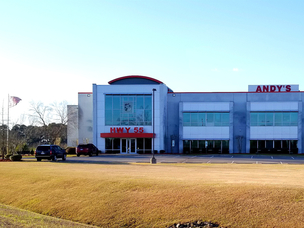
Civil War Trails Marker. Part of the North Carolina Civil War Trails program, this marker tells the story of the Union raid of Mount Olive on December 16, 1862. It was erected by the Mount Olive Area Historical Society in front of the Mount Olive Fire Department at 401 Northwest Center Street, and dedicated March 18th.
David John Aaron Teaching and History Museum. Opened April 28th by the Mount Olive Area Historical Society. Operated by the society and staffed by volunteers, it is located at 137 East Main Street.
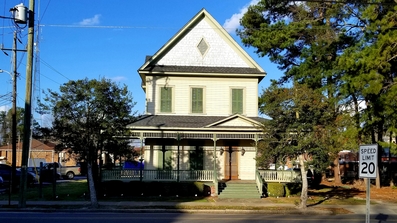
Mount Olive Veterans Memorial. Dedicated on November 10, the memorial was erected on the northeast corner of Main and Chestnut streets. It honors 75 from Mount Olive and surrounding areas who were killed in action from World War I through Iraq.
John Baxter Flowers III, “Early History of Mount Olive,” Mount Olive Tribune, September 7, 1979, Section B, pp. 1,3,5.
John Baxter Flowers III, “History of Mount Olive,” The Heritage of Wayne County North Carolina, Mary Daniels Johnstone (coordinator), published by The Wayne County Historical Association, Inc. and the Old Dobbs County Genealogical Society, 1982, pp. 40-43.